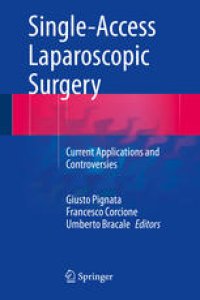
Ebook: Single-Access Laparoscopic Surgery: Current Applications and Controversies
- Tags: Minimally Invasive Surgery, Abdominal Surgery, Surgical Oncology, Colorectal Surgery, Surgery
- Year: 2014
- Publisher: Springer International Publishing
- Edition: 1
- Language: English
- pdf
Single-access laparoscopic surgery (SALS), performed using a single transumbilical access, has recently proved to bring advantages over other forms of laparoscopic surgery due to the reduction in the number of incisions and the consequent decrease in morbidity, less blood loss and postoperative pain. Furthermore, cosmesis may be improved because incision within the umbilicus renders surgery virtually scarless. Nevertheless, as with all new surgical concepts, questions may be raised regarding safety, usefulness and appropriateness. This book analyzes the use of SALS for different indications and abdominal surgical procedures based on a careful literature review of the experience of the most important surgical teams employing this approach and also the authors’ personal observations. The coverage is broad, encompassing, for example, the role of SALS in appendectomy, repair of abdominal wall defects, cholecystectomy, gastric surgery, nephrectomy, splenectomy, hemicolectomy and pancreatic, liver and gynecological surgery.
Single-access laparoscopic surgery (SALS), performed using a single transumbilical access, has recently proved to bring advantages over other forms of laparoscopic surgery due to the reduction in the number of incisions and the consequent decrease in morbidity, less blood loss and postoperative pain. Furthermore, cosmesis may be improved because incision within the umbilicus renders surgery virtually scarless. Nevertheless, as with all new surgical concepts, questions may be raised regarding safety, usefulness, and appropriateness. This book analyzes the use of SALS for different indications and abdominal surgical procedures based on a careful literature review of the experience of the most important surgical teams employing this approach and also the authors’ personal observations. The coverage is broad, encompassing, for example, the role of SALS in appendectomy, repair of abdominal wall defects, cholecystectomy, gastric surgery, nephrectomy, splenectomy, hemicolectomy, and pancreatic, liver, and gynecological surgery. Resident surgeons specializing in laparoscopy, researchers, and related healthcare professionals will find Single-Access Laparoscopic Surgeryto be an invaluable source of information in an area which deserves to receive detailed attention.